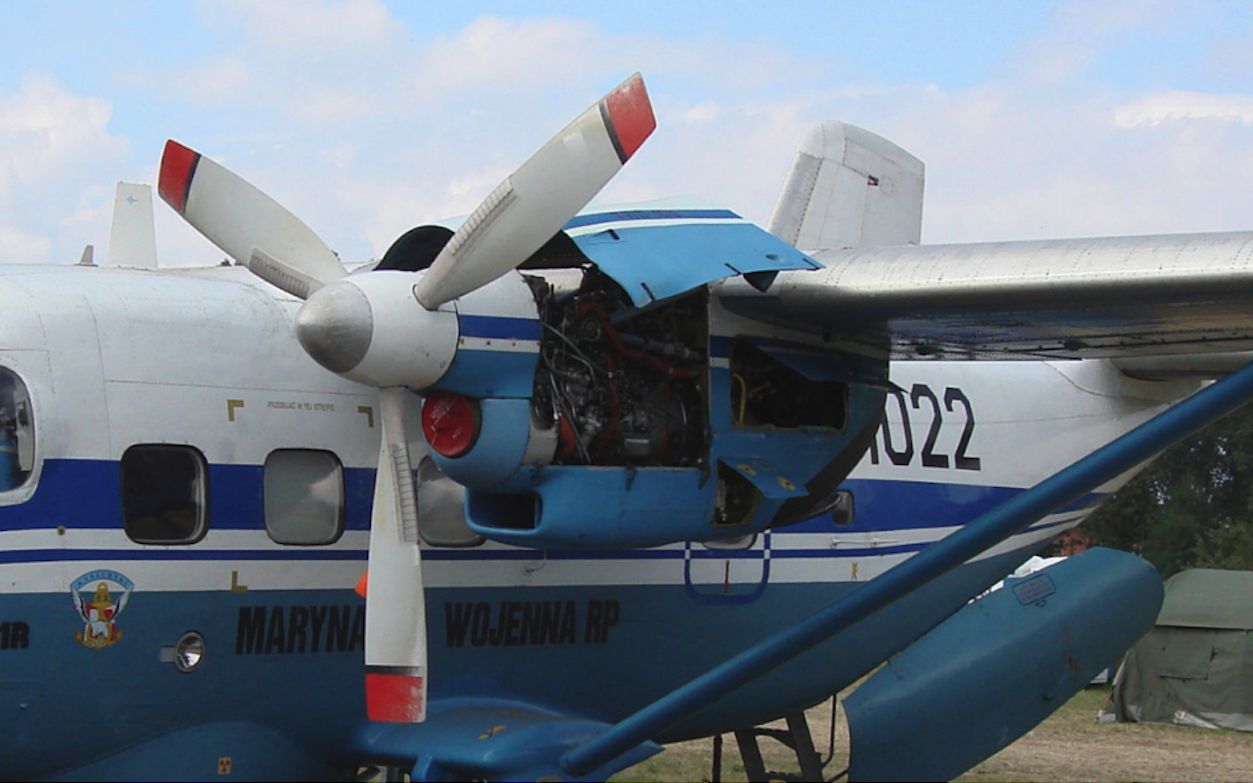Turboprop engines in Poland.
In Poland, turboprop engines were encountered in the 60 years, when LOT Polish Airlines received Il-18 (1961) aircraft with Ivcheniko AI-20 engines and An-24 aircraft (1966) with Ivchenko AI-24 engines. The same engines were used in the military An-12 (Ivchenko AI-20, 1966) and in the An-26 (Ivchenko AI-24, 1972). These engines were not produced in Poland.
Engine PZL-10 S. 1984 year.

In Poland, major changes took place with the licensed production of Antonov An-28 (PZL M-28) aircraft.
At the beginning of the 1960s, at the Oleg K. Antonov design office at CCCP in Kiev, work began on a small transport plane with short take-off and landing properties. The plane was designated An-14. Unfortunately, despite its advantages, the plane turned out to be too small. It should be assumed that the work was conducted as research, and it was not intended to create a utility plane. Therefore, a machine with twice the capacity was requested. This is how the An-14 M was born, which made its first flight in September 1969, but the machine required further work. The powertrain was too weak. In 1975, more powerful engines were mounted on the prototype. This modified plane was renamed An-28 and was flown in 1975. As we can see from the above description, work on this design was very slow. The CCCP industry, overburdened with military production, was unable to adequately deal with projects for civilian purposes. In 1978, talks began between Poland and the CCCP on placing the production of this type of aircraft in Poland. The Polish aviation industry took up this challenge, mainly because it was the recipient of finished products.
It should be noted that the An-28 prototype was only at the beginning of research and development. Which meant the completion of this stage of works in Poland. Obviously, such a situation had its good and bad sides, as we saw years later. The constructor of the aircraft who supervised the work on the An-28 in Poland was Dimitr Kiwa. Thanks to his statements, we know that in 1979 the state trials of this structure at CCCP were completed and the technical documentation was transferred to the Polish side. The Polish constructor was Kazimierz Kolisz. The employees involved in the production of the aircraft include; Wacław Kiepiela, Ryszard Flaum, Czesław Cyculenko, Stanisław Soluch, Sławomir Biliński, Henryk Zal, Andrzej Bakot, Henryk Moraoz, Mark Rzepecki, Mirosław Kasza, and many others. (data from Skrzydlata Polska from 1986).
Officially, on July 22, 1984, the first unit built at WSK PZL-Mielec made the first flight.
Simultaneously with the production of airplanes at PZL Mielec, the production of turboprop engines began at the PZL WSK Rzeszów plant. Since until now the only turbine engines produced in Poland were Lis-1, Lis-2, Lis-5, SO-1, SO-3, it turned out to be necessary to acquire new technologies. Belong to them; precise casting of engine working and steering vanes. Rolling of working blades. Surface hardening of the working blades by vibration method. Automatic welding in argon shield. Electron beam welding.
In 1984, the production of the TWD-10 B turboprop engine, which is the propulsion of the An-28 aircraft, began. This engine became the basis for the PZL-10 W engine, equipped with a free turbine, which together with the W-3 transmission became the drive of the PZL W-3 Sokół helicopter.
The Russian TWD-10 B engine had to be delivered to Polish raw materials, machines and technologies. This is how the PZL-10 S engine was created.
The PZL-10 S engine consists of: 6-stage axial compressor and one-stage radial (centrifugal) compressor. Annular combustion chamber with two spark plugs and a rotating injector. 2-stage turbine. Behind the two-stage turbine there is a single-turbine, a so-called slow turbine. The single stage axial turbine drives the propeller through a high speed reducer, idler shaft and forward planetary propeller reducer. Airplane aggregate drive box - through a high-speed reducer. The propeller reducer also drives the propeller speed controller and the drive turbine speed controller. The connection between the main spool turbine and the drive turbine is only gas-dynamic. A 3-blade Dowty propeller with a diameter of 2.8 m. At the end of the 90s, Hartzell 5-blade propellers began to be installed in the PZL-10 S engines. Such a drive was used in many Polish military M-28 Bryza.
Basic engine data; Propeller shaft take-off power of 705 kW (960 HP). The nominal power on the propeller shaft is 574 kW (780 HP). Engine dimensions: length 2.06 m, height 0.90 m, width 0.555 m. Weight 230 kg. Rotation speed of the main spool 31 537 rpm. The speed of the slow turbine is 24,445 rpm. Propeller rotational speed 1,826 rpm.
Written by Karol Placha Hetman
